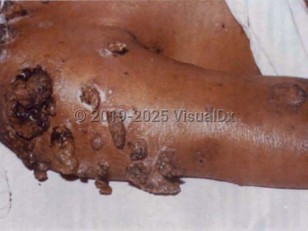Rhinosporidiosis
Alerts and Notices
Important News & Links
Synopsis

Rhinosporidiosis is a granulomatous mucosal infection caused by an aquatic protistan parasite (formerly thought to be a fungus), Rhinosporidium seeberi. This disease is endemic to the Indian subcontinent and East Africa but has been reported in North America and Europe on occasion.
Patients most often present with nasal obstruction and epistaxis. Because the disease almost always remains localized, they do not present with constitutional symptoms. Rarely, lesions may occur on genital mucous membranes. Lesions on extremities, trunk, or scalp occur rarely as well, and they may lead to underlying osteomyelitis. Overall, lesions other than nasal or ocular may occur in up to 8% of cases.
The inciting event is unknown, but trauma followed by environmental exposure is suspected. Men who have exposures to stagnant water that is used by livestock appear to be at increased risk, but the relationship is poorly understood. Young men (aged between 10 and 30), divers, and farmers are most commonly affected, with the exception of the ocular variant (oculosporidiosis), which occurs more commonly in women who live in urban settings. The lesions slowly progress over time; patients may present anywhere from 2 weeks to several years after becoming aware of the lesion.
Immunocompromised patient considerations: Case reports in immunocompromised patients are rare, but HIV coinfection may be associated with more extensive and numerous lesions.
Patients most often present with nasal obstruction and epistaxis. Because the disease almost always remains localized, they do not present with constitutional symptoms. Rarely, lesions may occur on genital mucous membranes. Lesions on extremities, trunk, or scalp occur rarely as well, and they may lead to underlying osteomyelitis. Overall, lesions other than nasal or ocular may occur in up to 8% of cases.
The inciting event is unknown, but trauma followed by environmental exposure is suspected. Men who have exposures to stagnant water that is used by livestock appear to be at increased risk, but the relationship is poorly understood. Young men (aged between 10 and 30), divers, and farmers are most commonly affected, with the exception of the ocular variant (oculosporidiosis), which occurs more commonly in women who live in urban settings. The lesions slowly progress over time; patients may present anywhere from 2 weeks to several years after becoming aware of the lesion.
Immunocompromised patient considerations: Case reports in immunocompromised patients are rare, but HIV coinfection may be associated with more extensive and numerous lesions.
Codes
ICD10CM:
B48.1 – Rhinosporidiosis
SNOMEDCT:
18140003 – Rhinosporidiosis
B48.1 – Rhinosporidiosis
SNOMEDCT:
18140003 – Rhinosporidiosis
Look For
Subscription Required
Diagnostic Pearls
Subscription Required
Differential Diagnosis & Pitfalls

To perform a comparison, select diagnoses from the classic differential
Subscription Required
Best Tests
Subscription Required
Management Pearls
Subscription Required
Therapy
Subscription Required
References
Subscription Required
Last Updated:01/02/2022
Rhinosporidiosis

